Renaissance Art – A Dive Into the World of the Renaissance Era
Renaissance art is the sculptural, painting, and decorative arts of the Renaissance period of European history, which arose as a distinctive aesthetic in Italy from 1400 AD, along with breakthroughs in music, science, philosophy, literature, and technology. Renaissance artists explored the artwork of Classical antiquity, which was regarded as the finest of historical traditions, but altered it by incorporating recent advancements in Northern European artwork and employing new scientific understanding. With the emergence of new methods and creative sensibilities, Renaissance humanism ideology expanded throughout Europe, influencing both Renaissance painters and their customers. In this article, we will examine the various Renaissance periods by chronologically going through the Renaissance timeline.
The History of Renaissance Art
For scholars, the Renaissance era represents Europe’s transformation from the Medieval times to the early years of the Modern era. The corpus of art, architecture, literature, and music collectively known as Renaissance art was predominantly created in Europe between the 14th and 16th centuries.
It was influenced by increasing awareness of the natural environment, a resurgence of classical works, and a more individualized vision of man.
Historians no longer assume that the Renaissance signified a sharp departure from Middle Ages ideals, as the French word renaissance, which translated means “rebirth,” suggests. Early Renaissance art coexisted with Late Medieval art in various regions of Europe.
The Origins of Renaissance Art
Numerous influences have been attributed to the rise of Renaissance art; these are the same factors that impacted literature, philosophy, religion, architecture, science, governance, and other parts of society. The following is an overview of changes in cultural and social situations that have been recognized as contributing factors to the creation of Renaissance art.
The Renaissance intellectuals focused on the present and strategies for improving human existence. They were uninterested in medieval religion or philosophy.
During this time, philosophers and humanists such as Dante, Erasmus, and Petrarch challenged and questioned superstitious beliefs. Classical literature that had been unavailable to European academics for centuries became available. Texts in prose, philosophy, theatre, poetry, science, art dissertation, and early Christian theology were among them. Europeans acquired access to sophisticated mathematics, which originated in Islamic thinkers’ writings. With the invention of moveable type print in the 15th century, concepts could be easily spread, and a growing number of publications were produced for a wider audience.

The Medici Bank’s formation and subsequent trading provided unparalleled affluence to a particular Italian city, Florence. Cosimo de’Medici established a new benchmark for sponsorship of the arts that was not linked to the church or the monarch. Humanist ideology emphasized that man’s interactions with mankind, the cosmos, and God were no longer only the domain of the church.
The artist Donatello and builder Brunelleschi conducted the first archaeological examination of Roman ruins as a result of renewed interest in the Classics.
The restoration of a classically inspired architectural style encouraged a parallel classicism in sculpture and painting which appeared as early as the 1420s in the works of Uccello and Masaccio. The advancement of oil paint and improvements in oil-painting processes by Belgian painters such as Jan van Eyck, Robert Campin, and Hugo van der Goes resulted in its acceptance in Italy in about 1475 and had long-term repercussions on painting methods worldwide.
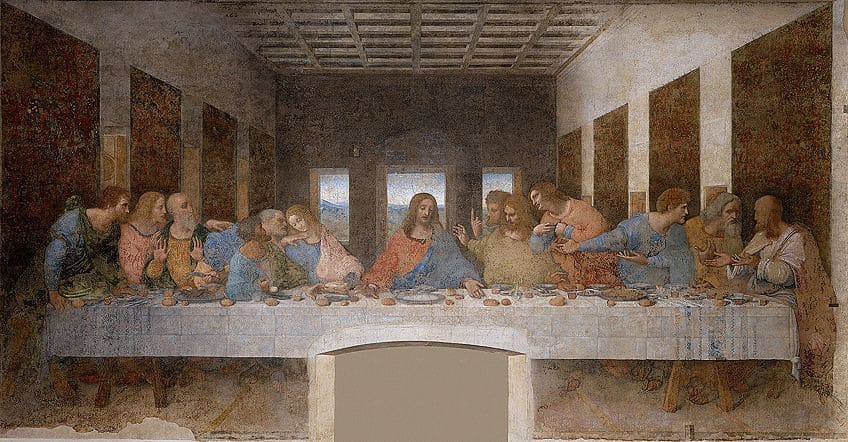
The appearance in the early 15th century of specific artistic geniuses, most particularly Brunelleschi, Masaccio, Piero Della Francesca, Ghiberti, Donatello, and Michelozzo, established an ethos from which emerged the enlightened beings of the High Renaissance, as well as encouraging and supporting many lesser creatives to accomplish work of exceptional quality. In Venice, the gifted Bellini family, their famous in-law Mantegna, Titian, Giorgione, and Tintoretto left a comparable legacy of artistic excellence.
Let’s now look at the specific Renaissance dates within which the various Renaissance time periods occurred!
The Proto-Renaissance Period: 1280 – 1400
During the late 13th and early 14th centuries in Italy, the sculptures of Nicola Pisano, who worked in Siena, Pisa, and Pistoia, has noticeably classicizing characteristics, which were most likely influenced by the artists’ knowledge of old Roman sarcophagi.
These works of art include the Cathedral of Pisa.
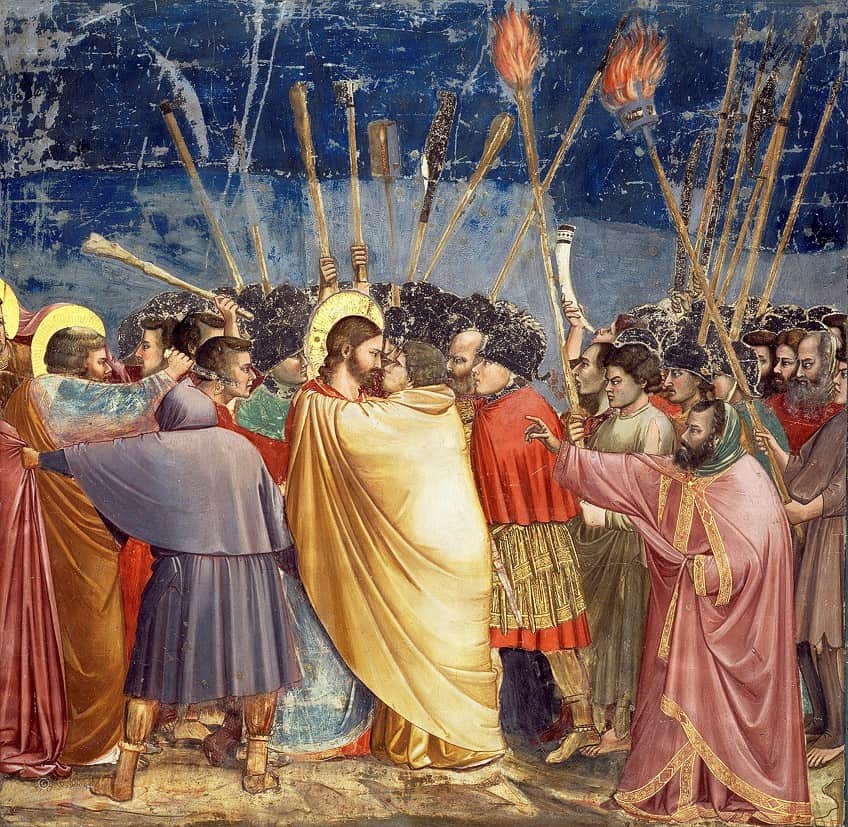
When compared to his colleagues and instructor Cimabue, the Florentine artist Giotto established a style of figurative painting that was astonishingly three-dimensional, realistic, lifelike, and classicist. Giotto, whose most famous masterpiece is the sequence of the Life of Christ (c. 1320) in Padua’s Arena Chapel, was regarded by the 16th-century writer Giorgio Vasari as recovering and reviving art from the coarse, conventional Byzantine style that prevailed in the 13th century in Italy.
Giotto di Bondone (1267 – 1337)
| Nationality | Italian |
| Date of Birth | c. 1267 |
| Date of Death | 8 January 1337 |
| Place of Birth | Vicchio, Italy |
During the Gothic/Proto-Renaissance period, Giotto di Bondone flourished. Giovanni Villani, Giotto’s contemporary, said that Giotto was the most authoritative master of painting in his day, producing all of his poses and subjects by nature and his widely recognized and lauded ability and excellence.
Vasari portrayed Giotto as breaking with the prevailing Byzantine style and launching the glorious art of painting as we understand it today, establishing the method of drawing precisely from life, which had been abandoned for almost two centuries.

The Early Renaissance Period: 1400 – 1495
Even though both Giotto and the Pisanos had supporters and trainees, the first truly Renaissance painters did not appear in Florence until 1401 with a contest to produce a pair of bronze doors for the Florence Cathedral’s Baptistry, which attracted submissions from seven youthful sculptors including Donatello, Brunelleschi, and the subsequent winner, Lorenzo Ghiberti.
Brunelleschi is best known as the architect of Florence Cathedral’s dome as well as the Church of San Lorenzo, but he also made a variety of sculptural pieces, notably a life-sized crucifix at Santa Maria Novella, which is known for its realism.
His perspective studies are considered to have inspired the artist Masaccio. Donatello rose to prominence as the Early Renaissance’s finest sculptor, with his masterpieces such as the statue of David (c. 1440), one of the Florentine republic’s icons, and his excellent memorial to Gattamelata (1453), the very first large equestrian bronze sculpture to be produced since the Roman era. Masaccio, Donatello’s contemporary and artistic successor, initiated the Early Renaissance in Italian art in 1425, continuing Giotto’s century-old tendency toward the solidity of shape and realism of face and motion.
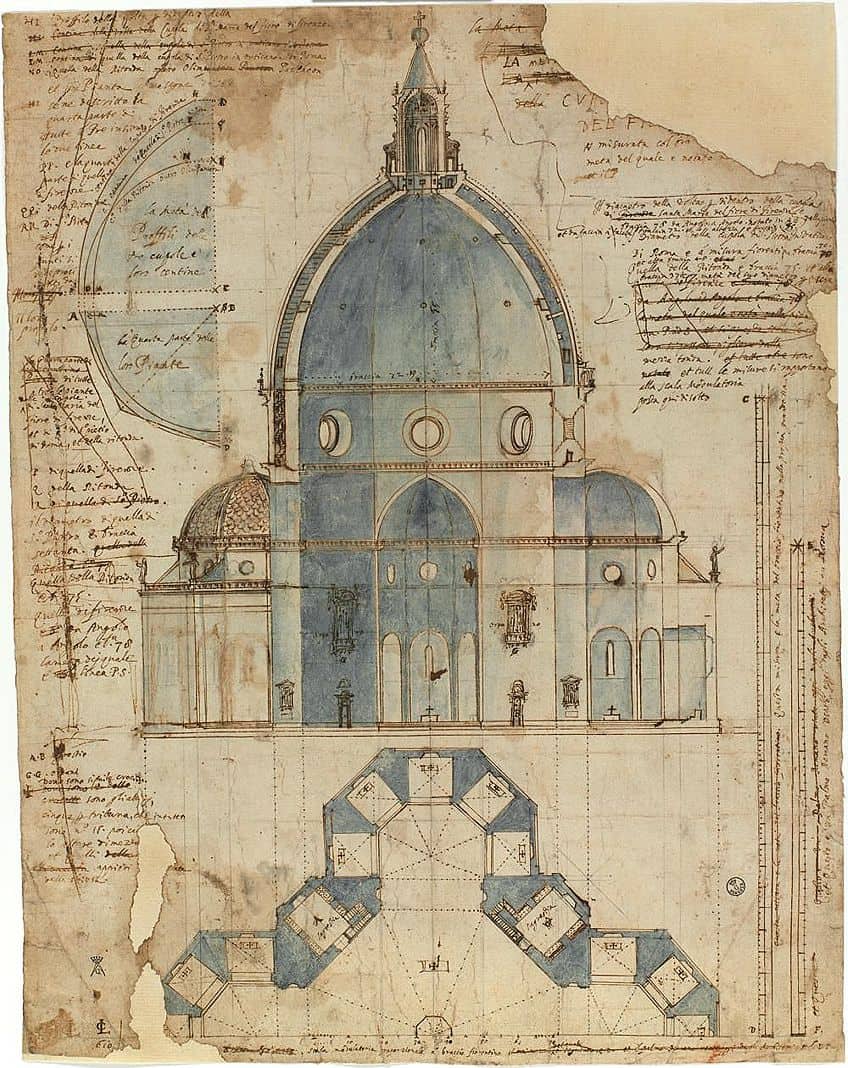
Masaccio painted many panel artworks between 1425 and 1428, but he is most remembered for the fresco cycle he started in the Brancacci Chapel alongside the elder artist Masolino and which had a major impact on succeeding Renaissance artists, notably Michelangelo. Fra Angelico’s works, notably his frescoes at the Convent of San Marco in Florence, continued Masaccio’s advancements. The use of viewpoint and light in art was especially important to 15th-century Florentine Renaissance artists.
According to Giorgio Vasari, Uccello was so consumed with achieving the impression of perspective that it disrupted his sleep.
His ideas may be seen in his masterwork series of three works, the Battle of San Romano, which was finished about 1460. Piero Della Francesca studied linear perspective in depth and light, the effects of which may be seen in his fresco cycle The History of the True Cross (c. 1466). Antonello da Messina, a painter from Naples, started utilizing oil paints for portraiture and religious works before other Italian artists, likely around 1450. He took this method north and inspired the Venetian artists.
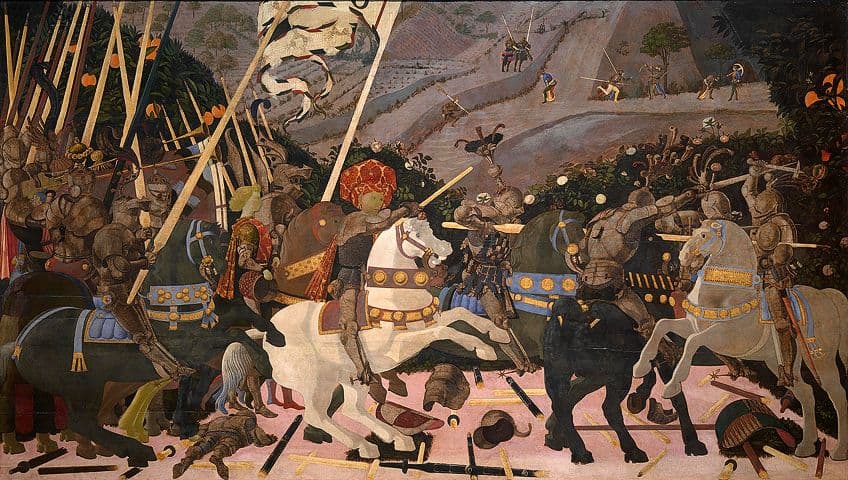
Andrea Mantegna, one of Northern Italy’s most important artists, adorned the inside of a room, the Camera degli Sposi, for his client Ludovico Gonzaga, incorporating images of the family and palace into an illusionistic architectural style. The conclusion of the Early Renaissance in Italian art, like the start, is characterized by a specific commission that pulled Renaissance painters together, this time in collaboration instead of rivalry.
Pope Sixtus IV restored the Papal Chapel and appointed a group of painters, including Pietro Perugino, Sandro Botticelli, Cosimo Rosselli, and Domenico Ghirlandaio, to cover its walls with fresco cycles representing the Life of Christ.
The painters agreed on design fundamentals and used lighting, atmospheric and linear perspective, foreshortening, anatomy, and characterization processes that had been taken to a high point in the huge Florentine workshops of Verrocchio, Ghiberti, Perugino, and Ghirlandaio in the 16 large works.
Antonello da Messina (1430 – 1479)
| Nationality | Italian |
| Date of Birth | c. 1430 |
| Date of Death | February 1479 |
| Place of Birth | Messina, Italy |
In some ways, Antonello da Messina is the first genuinely European artist, and his incredibly diverse talents pose concerns critical to our comprehension of European art. No other 15th-century Italian painter reacted in such a direct manner not just to the leading artists Jan van Eyck and Petrus Christus in particular – but also to titans of French Provençal painting such as Enguerrand Quarton.
Antonello da Messina’s success as a landscape and portrait painter would be unfathomable without these old masters.
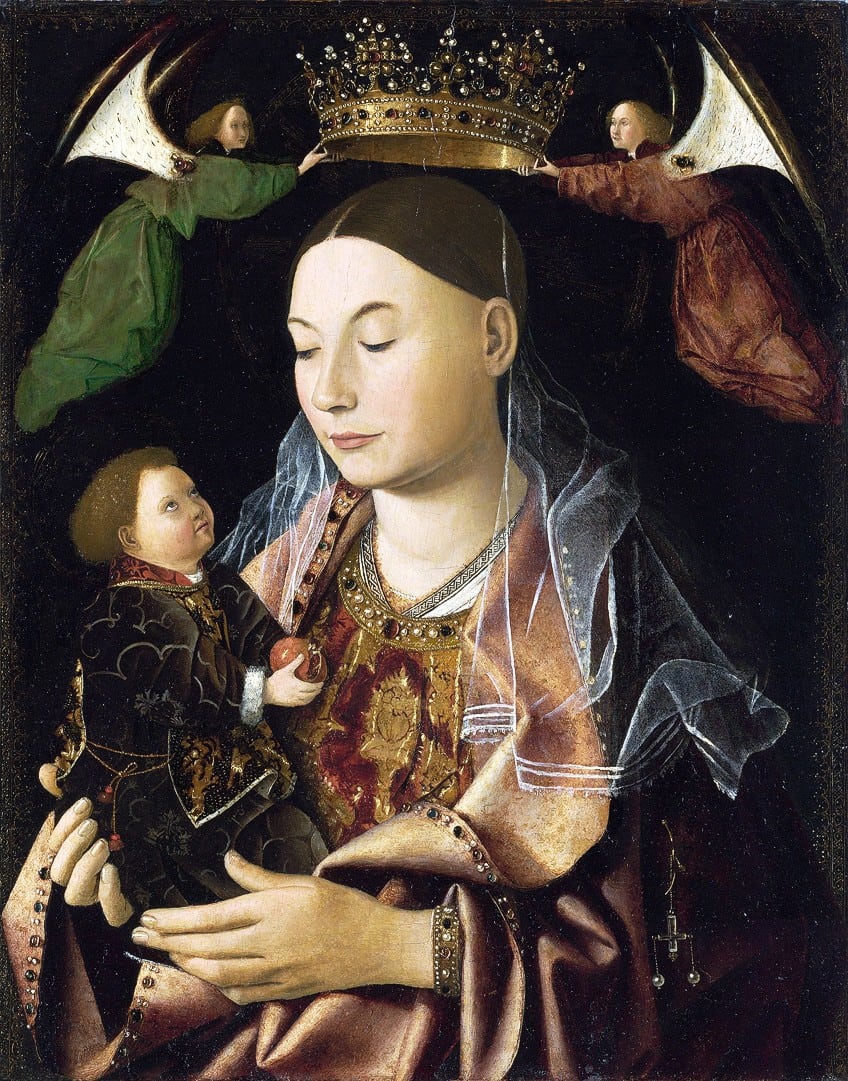
It remains one of the most interesting enigmas of Italian art that the individual who properly interpreted the works of his northern peers both Franco-Flemish and Netherlandish – was born, instructed, and appears to have worked for the majority of his professional life in Sicily.
The Early Netherlandish Art Period: 1425 – 1525
During this Renaissance period, the Low Countries’ artists included Jan and Hubert van Eyck, Hans Memling, Hugo van der Goes, and Rogier van der Weyden. Their artwork evolved in part separately from Early Italian Renaissance paintings, and without the impact of a purposeful and intentional effort to resurrect antiquity.
The painting technique evolved straight from medieval tempera painting on panels, as well as other mediums like stained glass; fresco was less prevalent in northern Europe.
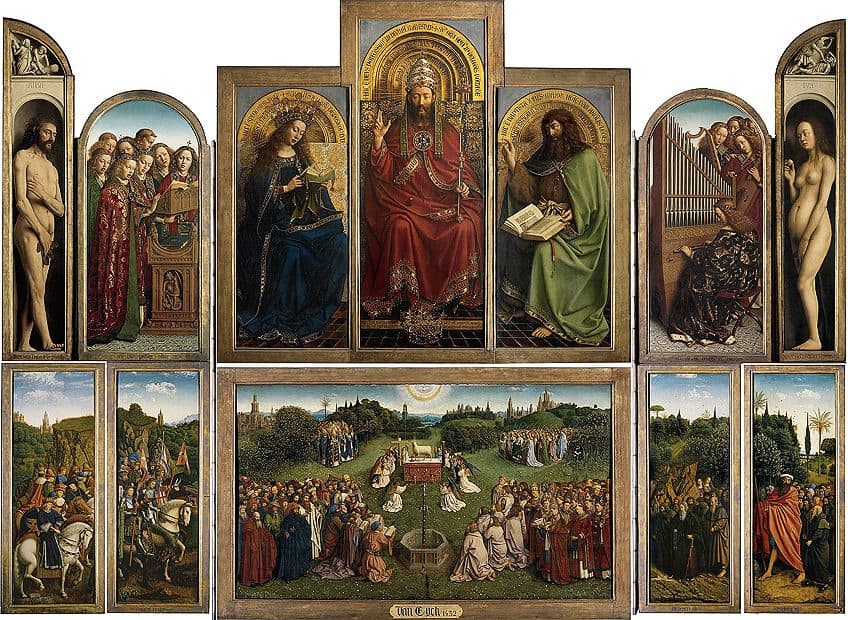
Since it was flexible and somewhat durable, oil paint has long been employed for painting leather ritual shields and ornaments. The first Dutch oil paintings, like tempera paintings, are precise and detailed. The medium allowed for the representation of tone fluctuations and texture, allowing for a more thorough study of nature. The Dutch artists did not approach painting from the standpoint of perspective and perfect proportion.
They preserved a medieval perspective on hierarchical proportion and holy iconography while enjoying a realistic presentation of nature and man-made materials.
The Altarpiece of the Mystical Lamb (1432) was painted by Jan van Eyck and his brother Hubert. Antonello da Messina most likely became acquainted with Van Eyck’s works while in Sicily or Naples. Hugo van der Goes’ Portinari Altarpiece came to Florence in 1475, where it had a great impact on numerous artists, most notably Domenico Ghirlandaio, who created an altarpiece based on it.
Hieronymus Bosch (1450 – 1516)
| Nationality | Dutch |
| Date of Birth | c. 1450 |
| Date of Death | 9 August 1516 |
| Place of Birth | ‘s-Hertogenbosch, Netherlands |
Hieronymus Bosch, a famous Netherlandish artist at the end of the era, used the sort of fantastical shapes that were commonly used to embellish margins and lettering in illuminated manuscripts, blending animal and plant forms with architectural ones. When removed from the framework of the illumination and populated with individuals, these shapes lend a strange character to Bosch’s works that none of the other Renaissance artists can match.
The Garden of Earthly Delights (c. 1515) triptych is his masterwork.
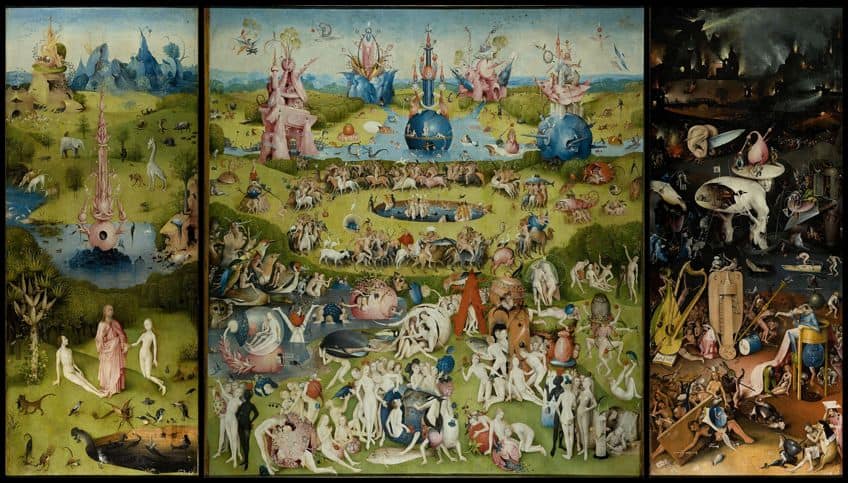
The Early Renaissance Period in France: 1375 – 1528
France’s painters were frequently affiliated with courts, producing illuminated manuscripts and portraiture for the aristocracy, as well as religious artworks and altarpieces. The Limbourg brothers, Flemish designers of the Très Riches Heures du Duc de Berry (1416) manuscript, were some of the most famous. A royal court artist, Jean Fouquet, visited Italy in 1437 and was influenced by Florentine artists such as Paolo Uccello.
Although he is most renowned for his portraiture, like the one of Charles VII of France, Fouquet also painted illuminations and is credited with inventing the portrait miniature.
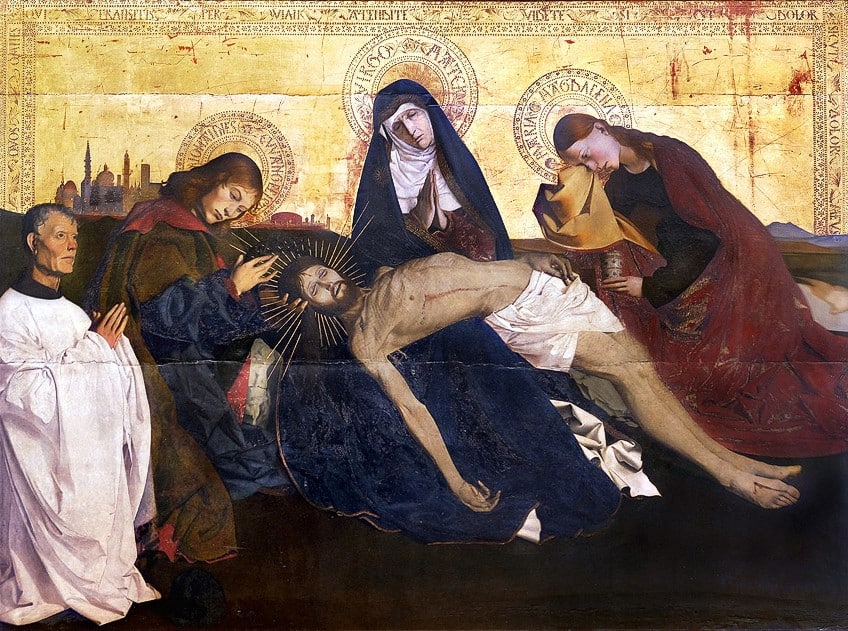
At this time, there were several painters who produced famous altarpieces that were aesthetically unique from both the Flemish and Italians. Enguerrand Quarton, to whom the Pieta of Villeneuve-lès-Avignon (c. 1460) is attributed, and Jean Hey, sometimes known as “the Master of Moulins” after his most renowned work, the Moulins Altarpiece (1498), is among them.
Realism and detailed study of the human figure, moods, and lighting are blended with medieval formalism, including gold backgrounds, in these paintings.
Enguerrand Quarton (1410 – 1466)
| Nationality | French |
| Date of Birth | c. 1410 |
| Date of Death | 1466 |
| Place of Birth | Laon, France |
Enguerrand Quarton, one of the finest Old Masters of 15th-century France, contributed to French painting in the areas of religious paintings, royal illuminated manuscripts, and altarpieces. Quarton created six canvases, but only two of them survived.
These magnificent works of Christian art blend aspects of Flemish painting and Gothic sculpture on the one hand, and themes from the Sienese Style of art on the other.
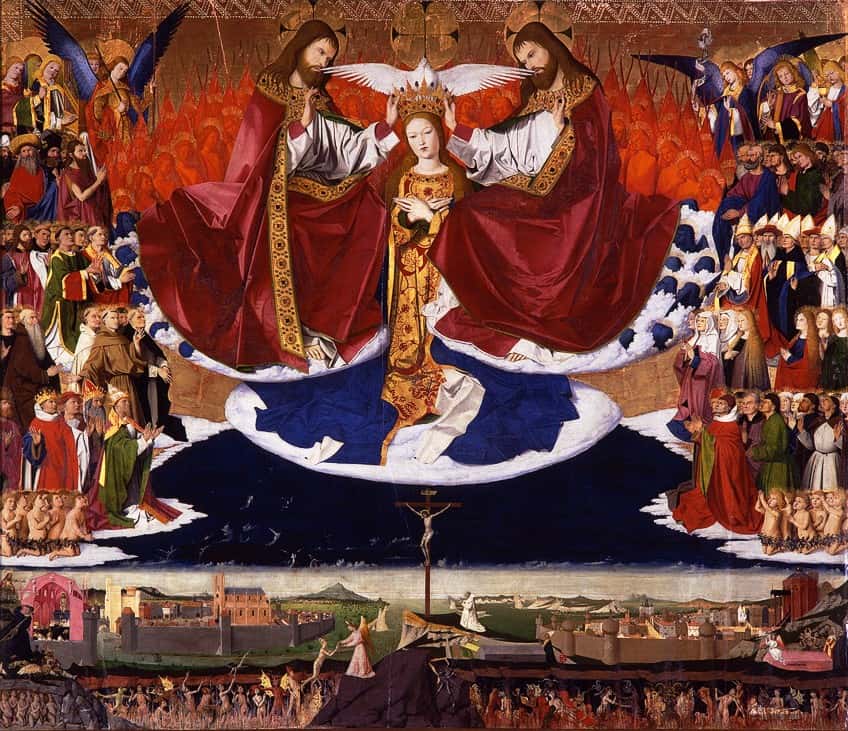
He is currently regarded as one of Europe’s best artists, alongside Jean Fouquet. Despite his standing as a great medieval painter and his considerable effect on religious artwork in Provence, as well as subsequent Italian and German works, Quarton fell into virtual anonymity until the Coronation of the Virgin (1454) was displayed in Paris in 1900.
High Renaissance Period: 1495 – 1520
In a career of studying and methodically recording his views of the natural world, Leonardo da Vinci would further improve the qualities of visual painting that concerned painters of the Early Renaissance. His use of oil paint as his primary medium allowed him to show light and its effects on the environment and things more realistically and dramatically than had previously been done, as exemplified by the Mona Lisa (c. 1503).
His cadaver dissections advanced our understanding of bone and muscle anatomy, as demonstrated in the incomplete Saint Jerome in the Wilderness (c. 1480).
His representation of human feeling in The Last Supper (c. 1498) established a new standard for religious art. Michelangelo, Leonardo’s younger contemporary, pursued a radically different path with his artwork. Michelangelo’s paintings and sculptures show little interest in the investigation of any other natural thing other than the human body. By creating the massive marble statue of David (1504) in his early 20s, he mastered his method of representing it. He subsequently began to investigate the expressive potential of human anatomy.

His appointment by Pope Julius II to decorate the ceiling of the Sistine Chapel resulted in the greatest masterwork of figurative arrangement, which had a considerable impact on every succeeding generation of European painters. His final masterpiece, The Last Judgement, which was produced on the altar wall of the Sistine Chapel between 1534 and 1541, demonstrates a Mannerist style with usually elongated figures that replaced the High Renaissance style between 1520 and 1530.
Along with Michelangelo and Leonardo, the younger Raphael was the third brilliant artist of the High Renaissance.
He produced a large number of life-like and appealing portraits, such as those of Pope Julius II and Pope Leo X, as well as numerous depictions of the Madonna and Christ Child. Many art scholars view his death in 1520 at the age of 37 to represent the end of the High Renaissance era, while some individual painters continued to produce in the High Renaissance manner for many years afterward. The High Renaissance In Northern Italy, is mainly characterized by participants of the Venetian school, particularly by Giovanni Bellini’s later works, notably religious works of art, which include multiple large altarpieces which depict a group of saints surrounding the Madonna.
Giorgione (1477 – 1510)
| Nationality | Italian |
| Date of Birth | 1477 |
| Date of Death | 25 October 1510 |
| Place of Birth | Castelfranco Veneto, Italy |
The Venetian High Renaissance started with the works of Giorgione, one of Bellini’s followers. Giorgione’s effect was great, even though he died at a young age. He presented new topics for the private delight of cultured patrons: mythical settings and pastorals with enigmatic significance. The mood is the fundamental “topic” of his works to an unparalleled degree. His paintings’ lyricism, like Italian poetry of the time, was intended to thrill and refresh.
Light and shade blend invisibly, and a subtle mood unites the landscape with humans, lending both a sense of mystery.
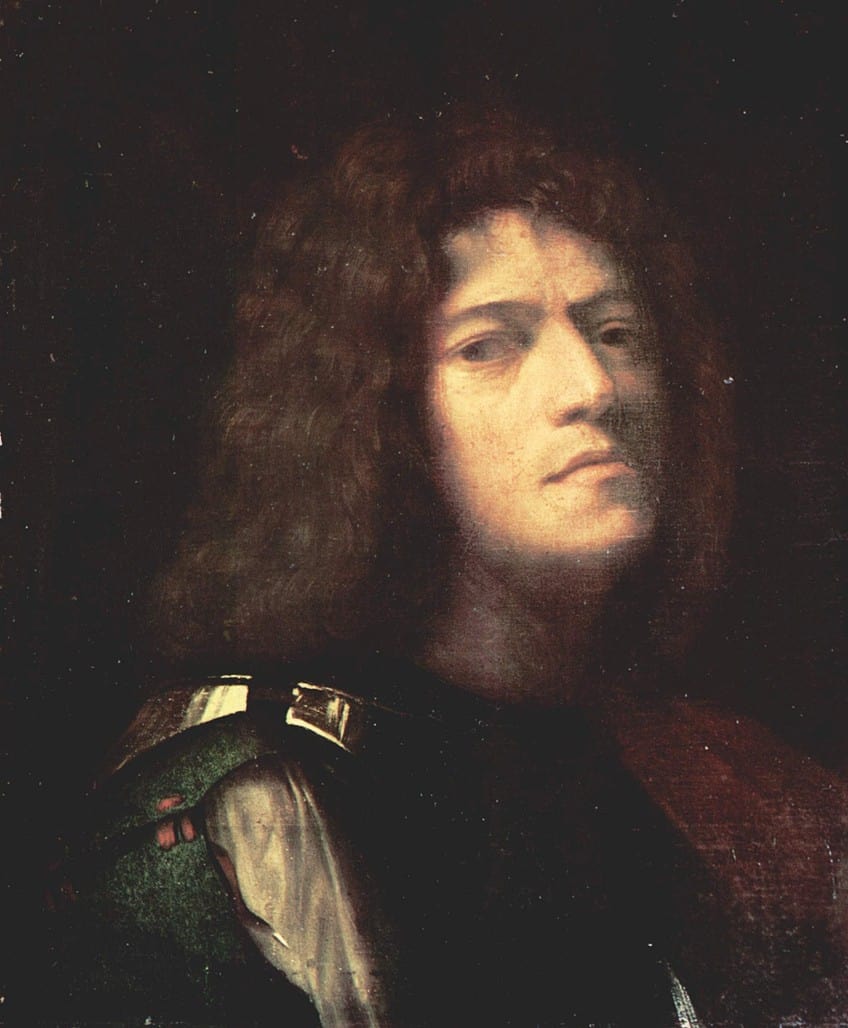
Giorgione, who died in 1510 at the young age of 32, left behind a small number of mysterious paintings, such as The Tempest (1508), the topic of which remains a mystery. Titian’s first works come from the High Renaissance period and include the huge artwork The Assumption of the Virgin (1518), which blends human movement and drama with stunning color and mood.
Titian continued to create in a broadly High Renaissance manner until the 1570s when he began to emphasize light and color over line to characterize his figures.
German Renaissance Era: 1500s
German Renaissance art belongs to the wider group of the Northern Renaissance. In the 15th century, Renaissance elements started to emerge in German artwork, but this movement was not pervasive. Michael Pacher, an artist, and sculptor is often identified as the first German painter whose works start to reflect Italian Renaissance elements.
Renaissance aesthetics became more popular in Germany in the 1500s.
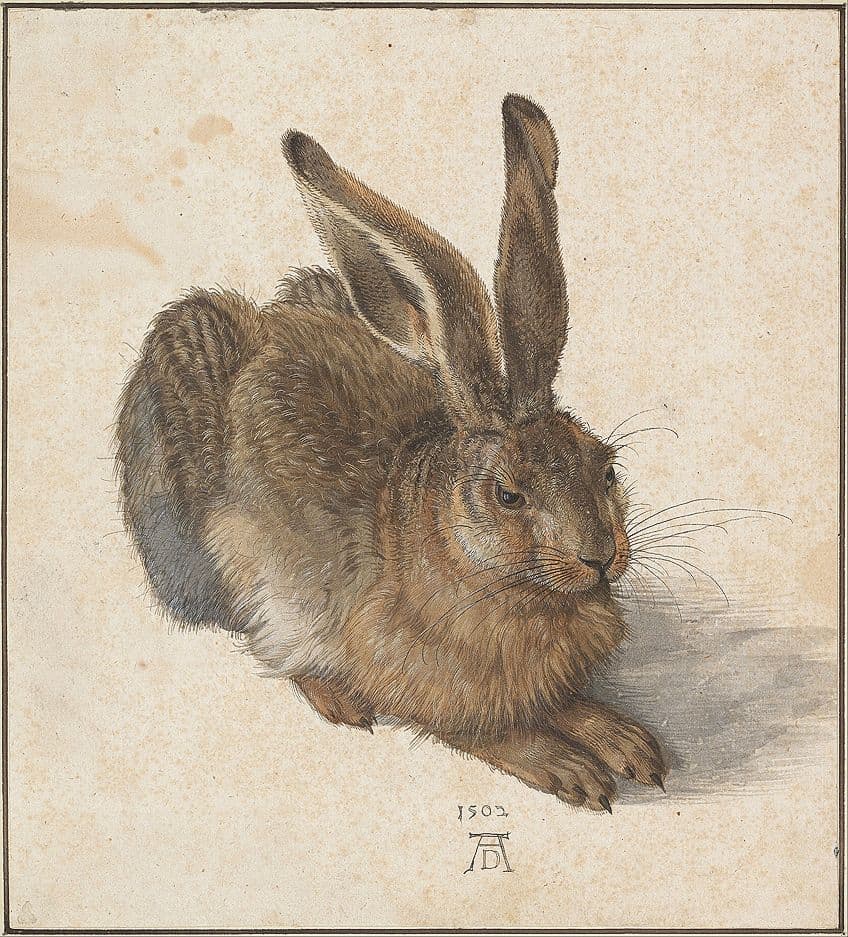
This was because the art of northern Europe during the 16th century was characterized by a rapid knowledge and understanding of the advancements made by the Italian Renaissance and by an eagerness to integrate this new look as quickly as possible.
Albrecht Dürer (1471 – 1528)
| Nationality | German |
| Date of Birth | 21 May 1471 |
| Date of Death | 6 April 1528 |
| Place of Birth | Nuremberg, Germany |
Albrecht Dürer was a well-known practitioner of German Renaissance painting, and his passion for classical concepts led him to Italy to pursue art. Many historians praised Dürer’s contributions to German art for introducing Italian Renaissance forms and concepts to Germany.
Although his technique did not always reflect this, Dürer was the first northern painter who thoroughly comprehended the crucial ideals of the southern Renaissance.

Hans Holbein the Younger skillfully blended Italian concepts with northern traditions of precise realism. This contrasts with Dürer’s preference for working in his German manner. Albrecht Altdorfer, Matthias Grünewald, and Lucas Cranach the Elder were also notable German Renaissance artists. Engravers, for example, grew more focused on aesthetics instead of merely mastering their skill. In the late 1400s, Germany had renowned engravers such as Martin Schongauer who produced metal engravings.
Historians attribute this proficiency of the graphic arts to printing improvements in Germany and claim that metal engraving started to replace woodcuts throughout the Renaissance.
The Renaissance Art of the British: 1550 – 1660
England was slow to develop visual arts in Renaissance traditions, and until the end of the Renaissance, the painters of the Tudor court were mostly imported foreigners; Hans Holbein being the most notable figure. The English Reformation resulted in a massive campaign of iconoclasm that obliterated practically all religious art of the Middle Ages and all but eliminated the craft of painting in Britain; for generations to come, English art would be characterized by portraits, and then later landscapes.
The portrait miniature was a notable English innovation that effectively adapted skills from the fading art of the illuminated book to little portraits carried in lockets.
Though the style was founded in England by foreign painters, notably Flemish such as Lucas Horenbout, locals like Isaac Oliver and Nicolas Hilliard created the best works by the late 16th century, even though the top creators of portraiture in oil were still foreigners. By the 18th century, the portrait miniature had swept across Europe.

Elizabeth I’s portraiture was meticulously managed and evolved into an ornate and entirely unrealistic iconic style that excelled in generating enduring portraits. The abundance of portraits influenced the history of English royal portraits during the Early Modern period.
Even the oldest images of Elizabeth I include symbolic things like prayer books and roses that would have meant something to people in her day.
Subsequent portraits of Elizabeth combine imperial imagery (crowns, globes, swords, and columns) with images of innocence and pureness (such as pearls and moons) to tell a complex tale that communicated to Elizabethan era audiences the grandeur and importance of their Virgin Queen. The Armada Portrait is a panel painting of Queen Elizabeth II surrounded by imperial emblems against a scene commemorating the destruction of the Spanish Armada in 1588.
Hans Holbein the Younger (1497 – 1543)
| Nationality | German-Swiss |
| Date of Birth | c. 1497 |
| Date of Death | c. 1543 |
| Place of Birth | Augsburg, Germany |
Holbein was a talented portraitist who lived in the 16th century. He lived in England for two years, representing the nobles of the Tudor court. The renowned picture of Henry VIII (1537) by Holbein stems from the second of these eras. The Ambassadors (1533), also from this period, represent two visits to Henry VIII’s court. Christina of Denmark (1538) is a picture of a possible king’s wife.
He traveled widely and is documented in northern Italy, Lucerne, and France. During these years, he created fresco compositions, woodcuts, and panel paintings.

The Renaissance Art of the Scottish: 15th – 17th Centuries
There is little documentation about native Scottish painters throughout the Middle Ages. Although like in England, portraiture of royalty was utilized for duplicates and replicas, the renditions of native royal portraits that exist from the late medieval era are often rudimentary by European standards. Much more remarkable are the paintings or painters brought from the continent, notably the Netherlands, which is often regarded as the center of Northern Renaissance painting.
There is also a plethora of complex devotional books from the late 15th and early 16th centuries, most of which were created in France and the Low Countries for Scottish clients.

The wealth of 16th-century royal art is represented by surviving wood and stone sculptures, mural paintings, and Scottish Imperial tapestries. Stone carvings on the royal residence at Stirling Castle from the time of James V are based on German designs, and they feature modern, historical, and classical characters, similar to the remaining engraved oak portrait crests from the King’s Presence Chamber, widely recognized as the Stirling Heads.
Some ornamental wood carvings were created by French craftsmen who settled in Scotland, such as Andrew Mansioun.
Scotland’s ecclesiastical art suffered greatly as a consequence of Reformation iconoclasm, with nearly all historic stained glass, religious sculptures, and paintings destroyed. The loss of sponsorship produced a dilemma for local craftspeople and artists, who resorted to secular clients.
Andrew Mansioun (d. 1579)
| Nationality | French |
| Date of Birth | Unknown |
| Date of Death | 1579 |
| Place of Birth | Unknown |
Andrew Mansioun is known to have carved ornate woodwork, and engraved metal, and made molds for cast-iron embellishments and gun-founding. He contributed to the 33 surviving Stirling Head oak medallion portraits. These portrait roundels carved for the ceiling of the King’s Presence room at Stirling Castle were created from wood harvested in Polish forests. Conservators discovered remains of blue-grey indigo paint depicting the steel armor of some of the figurines that were originally painted.
Similar stone sculptures may be found on the façade of Falkland Palace. The painted topics may be related to classical mythology, the Stewart rulers, or Bible tales.

Characteristics of Renaissance Art
Numerous key qualities help us define Renaissance paintings and other art forms like Renaissance architecture and sculpture. All of these factors contribute to the aesthetic, the use of light and color, and the accuracy of the proportions depicted in these compositions. Concepts like contrapposto, naturalism, chiaroscuro, and linear perspective are examples of Renaissance characteristics.
Contrapposto
Contrapposto was invented by the Ancient Greeks in the fifth century BC. Historically, Contrapposto posed balance concerns, which artists addressed by adding support structures for their characters to rest on. Contrapposto died out throughout the Middle Ages and was reintroduced during the Italian Renaissance era.
Many Renaissance artists used contrapposto, which improved the authenticity of individuals and the way they posed, making the scene more dynamic and lifelike.
This method originated during the Classical period and was revived throughout the Renaissance period. It is frequently likened to flat and more vertical depictions of people from prior art eras. In contrapposto, the body is seen resting with one hip higher than the other and with greater weight on one leg than the other.
Naturalism
The most realistic paintings have a quasi-photographic look to them: a characteristic that necessitates a limited quantity of visual detail. The evolution of how painters analyzed the human form led to the creation of Naturalism. It was presented with greater realism, seeming more natural.
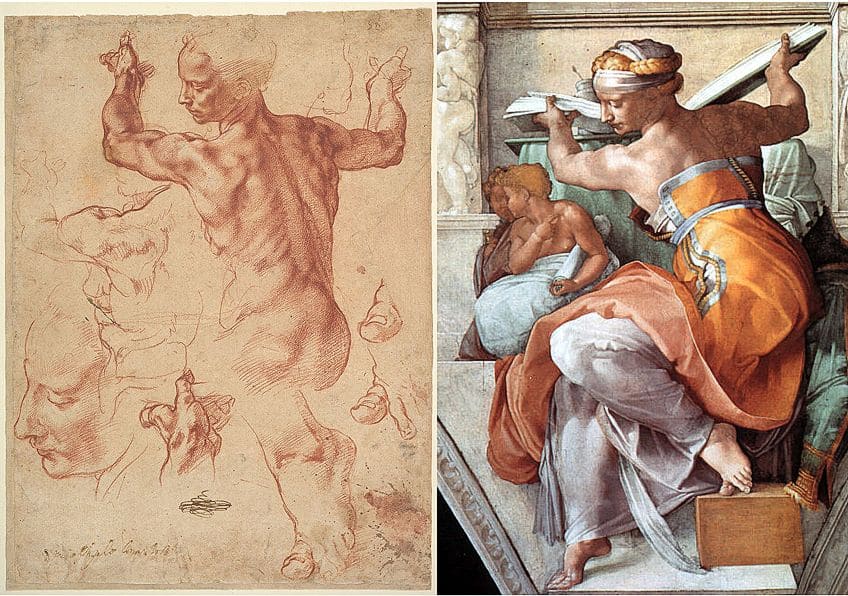
Some painters gained a greater understanding of human anatomy by examining dead bodies, resulting in more realistic depictions of limbs and muscles. However, landscape painting is the most common subject for the naturalism style.
Chiaroscuro
Although there is an indication that ancient Greek and Roman craftsmen exploited chiaroscuro, Leonardo da Vinci in the late 15th century was the first to fully use the method in European painting. Chiaroscuro is an Italian term that means “light-dark.” It incorporates the use of dark and light color contrasts to produce a three-dimensional image as well as increased emotionality. It also contributes to the composition’s naturalism by depicting shadows and light.
While the tone was an essential aspect of Medieval art, chiaroscuro was not. It became more significant to 15th-century artists, changing three-dimensional space portrayal.
The earliest significant image of a night scene is Taddeo Gaddi’s Annunciation to the Shepherds (1555). The angel is the image’s interior light source. Piero Della Francesca takes up the topic of the nighttime scene brightened by an angel in his Emperor’s Dream (1466) and utilizes his scientific understanding of light distribution. The resulting tonal pattern is an important component of the painting’s composition.
Sfumato
Sfumato is an Italian term having connotations comparable to the words soft, smoky, or fuzzy. This method was used to diffuse colors from light to dark, resulting in a haziness that gave the appearance of space or shape. It was also utilized to blur lines and borders, giving the composition a more natural appearance. This method was frequently used in landscapes for backdrops as well as to produce an “atmospheric” look on facial characteristics.

Linear Perspective
The vanishing point and linear perspective were two major strategies used to give the appearance of three-dimensionality in artworks. This was a groundbreaking method that allowed artists to create new spaces inside of their compositions and raise the status of their art to new heights, both literally and metaphorically, as well as illusionistically. Brunelleschi established that linear perspective is made up of parallel lines that converge at a vanishing point and merge with a horizon line.
Since there is only one perspective in the picture, this approach gave rise to the notion that each picture is observed by a single spectator. Medieval art, on the other hand, represented compositions from numerous perspectives.
Landscapes
The advancement of linear perspective and the incorporation of rich landscapes in the backgrounds of many Netherlandish works of the 15th century promoted the representation of landscape. This approach also brought knowledge of atmospheric perspectives and the observation of how light affects distant objects. Mantegna’s landscapes have a three-dimensional, sculptural, appearance that evokes actual physical space. The intricacies of the rocks, such as their layers and cracks, indicate that he researched the geological features of red limestone, which is common in Northern Italy.
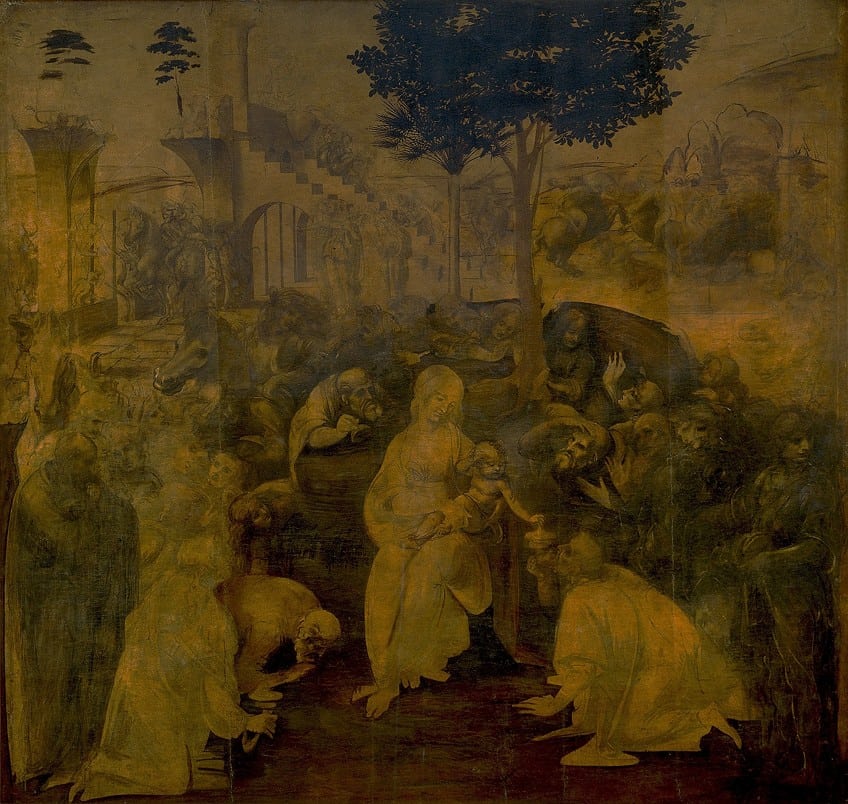
Leonardo da Vinci’s portrayal of the steep mountains at the foothills of the Alps in Northern Italy in The Adoration of the Magi (1481) demonstrates a dramatic use of atmospheric perspective. Giovanni Bellini produced a realistic setting with a pastoral scene between the foreground and backdrop mountains in Procession of the True Cross (1496). This landscape has several layers, making it the equivalent of Ghirlandaio’s intricate metropolis.
Anatomy
Leonardo da Vinci’s painstaking dissection of bodies enhanced anatomical knowledge. Da Vinci, among others, instilled in trainees the need for scrutiny of life and made live model drawing an integral element of the school’s formal art education.
Cimabue’s Crucifixion (1265), which was heavily damaged by a flood in 1966, exemplifies the formal arrangement, with a curved torso and hanging head, that was common in late Medieval art.
The anatomy is heavily stylized to adhere to the classic iconic formula. Michelangelo employed human anatomy to great effect in his sculptures. He was well-known for his ability to create emotive stances, which many other sculptors and artists emulated.
Themes
The topics that concerned Italian Renaissance artists were those of technique and subject matter- what was depicted and how it was produced. The artist had significantly greater leeway in terms of topic and style than a Medieval artist. Certain characteristics of Renaissance painting changed significantly during the period. The Flagellation of Christ (1460) by Piero Della Francesca exhibits numerous aspects of Italian Renaissance art in a single little piece, both regarding compositional features and subject matter. Piero’s command of light and perspective is immediately obvious.

The architectural features are combined to form two rooms, including a tiled floor that grows incredibly intricate around the focal action. The interior area is illuminated by an invisible light source, at which Jesus is looking. An examination of the dispersion and direction of the shadows on the beamed ceiling helps locate its exact position. The three people standing outside are illuminated from various angles, including sunlight and light projected off the sidewalk and walls. The depicted people’s creative execution is linked to the artwork’s immediate historical setting.
That concludes our look at the various Renaissance dates that encompassed the full Renaissance timeline. The time in Europe known as the Renaissance, which lasted from the 14th through the 17th centuries, signified a rebirth or resurgence of enlightenment and wisdom. The Renaissance era had an impact on many aspects of European civilization, including religion, art, literature, and politics. The Renaissance period saw an increasing awareness of nature as well as a renaissance in the study, all of which were present in the medieval period but grew more prevalent in the 15th and 16th centuries. The portrayal of the individual perception of a man was central to Renaissance paintings. Many great Renaissance painters created magnificent works throughout the Renaissance dates defined above, which are still respected today.
Take a look at our Renaissance art period webstory here!
Frequently Asked Questions
What Are the Characteristics of the Renaissance Period?
Various fundamental characteristics help us understand Renaissance paintings as well as other art forms such as Renaissance architecture and sculpture. All of these elements add to the composition’s beauty, the use of light and color, and the precision of the proportions represented. Renaissance traits include concepts like contrapposto, naturalism, chiaroscuro, and linear perspective. Contrapposto increased the scene’s energy and lifelikeness by improving the accuracy of people and how they posed. The growth of how artists examined the human form resulted in the birth of Naturalism. Chiaroscuro uses dark and light color contrasts to create a three-dimensional image with greater emotionality.
Was the Renaissance Only in Italy?
The concept of the Renaissance spread far and wide. There were also Renaissance artists in the Netherlands. Britain and Scotland also experienced a renaissance in their art and culture too. The Venetian Renaissance was also unique when compared to the rest of Italy.
What Is the Renaissance Meaning?
Literature and art flourished during the Renaissance, meaning that people became more enlightened and educated. It was a revival of the more classical styles that were popular centuries before. Rebirth is another word for Renaissance, meaning that certain ideas and principles emerged that were once held in high regard.
Jordan Anthony is a Cape Town-based film photographer, curator, and arts writer. She holds a Bachelor of Art in Fine Arts from the University of the Witwatersrand, Johannesburg, where she explored themes like healing, identity, dreams, and intuitive creation in her Contemporary art practice. Jordan has collaborated with various local art institutions, including the KZNSA Gallery in Durban, the Turbine Art Fair, and the Wits Art Museum. Her photography focuses on abstract color manipulations, portraiture, candid shots, and urban landscapes. She’s intrigued by philosophy, memory, and esotericism, drawing inspiration from Surrealism, Fluxus, and ancient civilizations, as well as childhood influences and found objects. Jordan is working for artfilemagazine since 2022 and writes blog posts about art history and photography.
Learn more about Jordan Anthony and about us.
Cite this Article
Jordan, Anthony, “Renaissance Art – A Dive Into the World of the Renaissance Era.” artfilemagazine – Your Online Art Source. November 7, 2022. URL: https://artfilemagazine.com/renaissance-art/
Anthony, J. (2022, 7 November). Renaissance Art – A Dive Into the World of the Renaissance Era. artfilemagazine – Your Online Art Source. https://artfilemagazine.com/renaissance-art/
Anthony, Jordan. “Renaissance Art – A Dive Into the World of the Renaissance Era.” artfilemagazine – Your Online Art Source, November 7, 2022. https://artfilemagazine.com/renaissance-art/.



